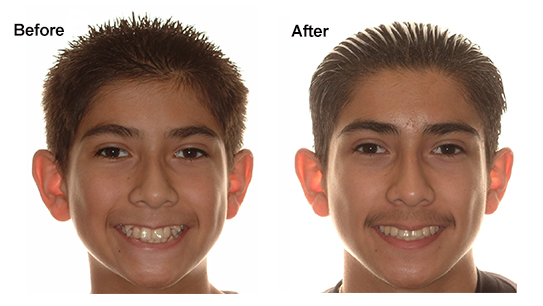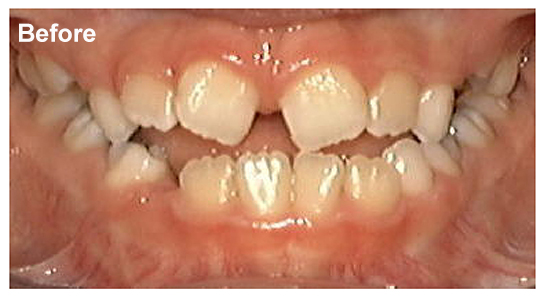October 31st, 2016

WE DON’T think much in our daily lives about being a walking, talking human skeleton. When our orthodontist shows us our lateral cephalogram radiograph for the very first time, it can be quite surprising to see our actual skull and skeleton.

The lateral cephalogram is analyzed by orthodontists for the diagnosis of facial soft tissues influenced by the underlying jaw bone and teeth. Using this analysis, orthodontists produce the beautiful profiles and deliver desires facial esthetics.
Lateral Cephalograms Help Find Certain Bite Issues
When there is a big overjet, overbite, or underbite of the teeth, the lateral cephalometric analysis helps the orthodontist determine which jaw or teeth are responsible for the situation. The analysis of this X-ray can help determine what type of treatment is necessary and whether or not jaw surgery or extractions are needed.

The lateral cephalogram allows the orthodontist to evaluate front tooth position in bone. This helps decide final tooth position for the most stable, beautiful, and functional result. In addition, this analysis indicates whether or not teeth need to be extracted for ideal periodontal health.

The lateral cephalometric analysis gives the orthodontist information about vertical face height and lower jaw angle. This helps decide what treatment mechanics to use to keep the bite functional, beautiful, and closed.

The Lateral Cephalogram Is Critical For Ortho Evaluation
The lateral cephalogram and it's analysis is critical for a thorough orthodontic evaluation. Ask your orthodontist to see your lateral cephalogram radiograph and explain your analysis. Your life may never be the same after the day you realize you are a walking, talking skeleton.
This blog was written by Dr. Ann Marie Gorczyca, Gorczyca Orthodontics, Antioch, California www.clubbraces.com (925) 757-9000. To find an orthodontist near you, visit the American Association of Orthodontists at www.mylifemysmile.org.
Tags: orthodontist, orthodontics, braces, openbite, overbite, overjet, Underbite, facial esthetics, skeleton, Lateral cephalogram, lateral ceph, cephalometrics, dental radiology, imaging, tooth position, jaw position, cephalometric analysis, orthodontic analysis, soft tissue analysis, soft tissue, soft tissue profile, beauty esthetics, beauty, esthetics, facial profile
Posted in Blog | No Comments
November 5th, 2015

SOMETIMES FOR THE MOST gorgeous and healthy smile possible, orthodontic tooth extractions are necessary.
5 Situations When Tooth Extraction is Best
Here are a few situations when it would be best to extract teeth with your orthodontic treatment:
- Teeth are severely crowded with 10mm and the bone and periodontal soft tissue cannot accommodate expansion.
- There is a severe open bite which can be reduced and corrected by tooth extraction.
- The lips are severely protrusive or open at rest.
- The chin has strain at rest when the lips close, giving it a "golf ball" appearance.
- There is a severe overjet with upper teeth extremely protrusive.

Extractions are less common in young patients who are still growing and are able to have arch expansion and growth modification.
Tooth Extraction Can Be A Simple Process
Tooth extraction is usually done by an oral surgeon. Depending on their training and experience, some general dentists may also extract permanent teeth.
The extraction of bicuspids and other teeth (not including wisdom teeth) is usually simple. It is usually done quickly. With anesthesia, there is usually no discomfort. Once home, be sure to eat soft food and avoid using a straw immediately following the procedure. There is no need to miss school following the procedure.

At Gorczyca Orthodontics, we try to minimize tooth extraction as much as possible. To find out if tooth extraction is absolutely necessary for you, visit us at www.clubbraces.com or call us at (925) 757-9000. To find an orthodontist in your area, visit the America Association of Orthodontists at www.mylifemysmile.org. To find an oral surgeon in your area visit the American Association of Oral Surgeons at www.aaos.org.
Thank you for trusting us with your orthodontic care. Here's to your beautiful smile.
Tags: orthodontist, orthodontics, braces, dental crowding, extractions, openbite, overjet, lips, profile, protrusion, oral surgeon, maxillofacial oral surgeon, When Are Orthodontic Extractions Necessary?
Posted in Blog | No Comments
August 25th, 2015

WITHIN FAMILIES, it’s obvious that facial features are hereditary. The best known example is the Habsburg Family, a royal family with large lower jaws.
Anterior crossbites, openbites, or both are seen in parents and grandparents, aunts and uncles, siblings, and cousins of large lower jaw patients. Inheritance is strong. In a recent study, the heritability of mandibular prognathism (large lower jaw) was estimated to be 0.316 and autosomal dominant, suggesting a major gene influences large lower jaw growth.

Large lower jaws are present as early as age 7. This is why when your orthodontist sees an underbite or openbite with a large lower jaw, they will do an in-depth analysis of jaw growth as well as take a careful family history for large lower jaw, called Class III skeletal malocclusion.

Genetically programmed large lower jaw growth cannot be prevented. Maxillofacial surgeons have been doing large lower jaw surgery for decades and often do several hundred per year. This surgery may be done at age 16 in females and age 21 in males. Your orthodontist can take a hand-wrist film to look at radius bone growth completion to determine the best time for orthognathic surgery (jaw surgery).

This case was treated by board certified orthodontist Dr. Ann Marie Gorczyca of Gorczyca Orthodontics, Antioch, CA. Find us at www.clubbraces.com or call us at (925) 757-9000 to schedule a complimentary jaw assessment.
Find out if you have the royal jaw. If you would like a commoner smaller lower jaw, we're here to help.
Tags: openbite, anterior crossbite, Class III, maxillary advancement, orthognathic surgery, large lower jaw, prognathism, mandibular prognathism, skeletal class III, Class 3, Underbite, maxillofacial surgeon, mandibular setback, hand wrist film, skeletal malocclusion
Posted in Blog | 1 Comment
February 10th, 2015

THUMBSUCKING IS A HARD HABIT TO BREAK. A survival instinct at birth, the longer someone sucks their thumb, the harder the habit is to stop.
Dr. Ann Marie Gorczyca, Board Certified Orthodontist says, “People think that only children suck their thumb. I can tell you from experience treating the habit, that this is not the case. Over the course of my 25 year career, I have treated plenty of children to stop thumb sucking. I have also treated high school football players, engaged women getting ready to be married, and people over the age of forty. The longer you wait to stop sucking your thumb, the harder the habit is to break.”
Thumb Sucking Should Be Stopped By Age 7
Thumb sucking cessation is best treated at age 7. Thumb sucking with baby teeth has little or no long term effects on permanent tooth position. Psychologists argue that there is a psychological benefit to thumb sucking at a very early age. But after age 7, thumb sucking will create a malocclusion (bad bite) including flared front teeth, spaced upper teeth, pushed in lower teeth, a narrow upper arch, and front tooth openbite. These are serious bite problems.
An Appliance Can Help Stop Thumbsucking
If caught early, thumb sucking can be treated with a upper jaw habit appliance only. This appliance will stop both the thumb sucking habit and allow the open bite to close naturally.


Orthodontic treatment may also be needed to expand the upper arch and align front teeth after thumb sucking. This is usually done between the ages of 7 to 9 during Phase 1 orthodontic treatment.

Some Tips To Stop Thumbsucking At Home
There are things you can try at home to stop thumb sucking.
- Place a band aid on the finger as a reminder not to suck the finger.
- Put the finger into something which does not taste good like hot sauce, vinegar, or mustard as a taste reminder not to suck the finger.
- Put a smelly sock or a glove on the hand as a smell and touch reminder not to suck the finger.
At any age, your orthodontist can help you stop thumb sucking. To find an orthodontist near you visit www.mylifemysmile.org or visit us at Gorczyca Orthodontics in Antioch, California at www.clubbraces.com. Call us at (925) 757-9000 for a complimentary exam.
Stop thumb sucking! Isn’t time to kick the habit?
Tags: Antioch, orthodontist, orthodontics, braces, Dr. Gorczyca, Gorczyca Orthodontics, openbite, finger habit, habit appliance, Phase 1 braces, thumbsucking
Posted in Blog | No Comments
November 13th, 2014

It was the best of times...

“Have you ever thought of having orthodontic treatment?”
It was the age of wisdom...

“I have already had orthodontic treatment” is often heard with openbites.
It was the epoch of belief...

Openbites are skeletal or dental. They are not caused by tongue thrust.
It was the season of light...

All orthodontic problems can be solved. Adult openbite is one of them.
It was the spring of hope...

Get It Corrected By An Orthodontist For The Best Results
Openbite correction in adults may require extractions, surgery, or placement of temporary anchorage devices (TADs) with braces or Invisalign.
Whether you’re in London, Paris, or Antioch, California, openbites corrected by an orthodontic specialist will give you far, far better results. Your smile will be beautiful, healthy, stable, and possibly “illustrious”.
If you have questions about adult openbite, call Dr. Ann Marie Gorczyca at Gorczyca Orthodontics (925) 757-9000 for a complimentary consultation. You can visit us at www.clubbraces.com.
To find an orthodontist near you, visit the American Association of Orthodontists at www.mylifemysmile.org. Non-US orthodontists are also members of the AAO or the World Federation of Orthodontists.
Make it your best of times.





























